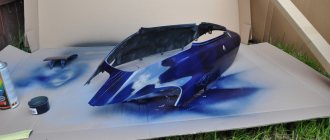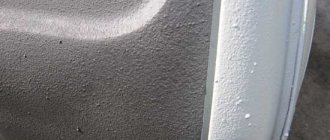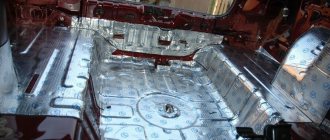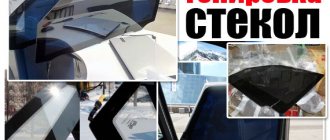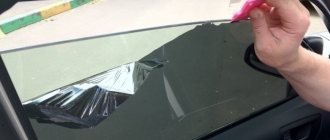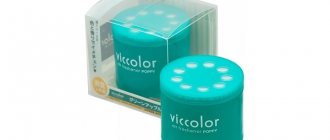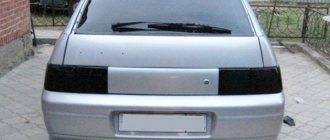Carbon film is one of the types of vinyl films that car enthusiasts often use during car styling and tuning. At the moment, this film has become widely used, and all because it is easy to use and also has a relatively low cost. But it should be borne in mind that this vinyl film has nothing in common with natural carbon, except for its appearance. At the same time, a similar appearance allows you to stylistically decorate your car without using expensive material.
Carbon film is one of the types of tuning that changes the appearance of the car
Carbon fiber material, popularly called “carbon,” has become popular among car owners due not only to its high strength indicators, but also to the spectacular appearance that weaves of carbon fibers give this material. But this material has a high cost, so not everyone can buy and install carbon elements instead of standard ones, especially if this element also has a significant area, for example, a hood. This is where vinyl film, which is similar in appearance to carbon fiber material, comes to the aid of car enthusiasts, hence the name of the film - carbon.
Description
Carbon-effect film for cars is made of a polyvinyl chloride base with an adhesive surface. A 3D image is applied to the PVC, which imitates the texture of carbon fiber. Thanks to this, the carbon-look film for tuning is visually indistinguishable from real carbon fiber and also gives its owner a high status. Most often, this film is used on cars for pasting:
- torpedo component;
- door handles;
- doors;
- hood
The main task of carbon film is to protect the body and other parts of the car from external damage and corrosion.
Carbon film is flexible, which eliminates the formation of swelling, creases or other imperfections even when applied to an uneven surface. As for colors, carbon films in black and graphite colors are very popular. On sale are models with a steel, chrome effect, as well as pearlescent and matte films for the car in different shades.
Carbon film for covering your car with carbon film
Pasting with carbon film is used in various fields. Of course, carbon is used in car tuning, in auto-moto sports (racer equipment and vehicle parts), in military technologies (special uniforms, weapons, equipment), even in jewelry and clothing, with more and more cases of carbon being used every day.
The main feature and advantage of carbon is its low weight and high strength. It is thanks to this that carbon began to be used in some parts of racing cars, since these are the winning characteristics that are relevant. The carbon fiber appearance is definitely another plus. It looks unusual, expensive and beautiful.
Advantages and disadvantages
Carbon film on cars has the following advantages:
- not exposed to UV radiation;
- resistant to temperature changes;
- not exposed to chemicals, road abrasives, moisture;
- allows you to wash your car using high pressure washers;
- hides minor defects on the car (scratches, paint chips);
- looks very expensive and stylish;
- sticks not only to metal, but also to plastic and glass;
- easy to remove;
- It is used for an average of 5 years without losing its properties. Also, cracks do not form on this film.
Now there is a huge amount of carbon film on the market with various design solutions.
Carbon film on a car, in addition to its advantages, also has a main drawback - high cost.
When buying a more affordable substitute for PVC carbon film, you must understand that it has worse characteristics compared to carbon fiber, so it will last less.
Carbon film on cars
Every person is different and everyone wants to stand out from the crowd in their own way.
Car enthusiasts have an interesting way. Carbon fiber pasting, both external and internal, is a great way to show a person’s individuality. As for external car tuning, until recently one of the most popular body styling options was colored vinyl. But with the advent of new products in the automotive industry, new, innovative methods and technologies for car tuning appear. Carbon 3D film is an innovative material that exactly imitates the texture of natural carbon to the touch and visually. This is a practical and effective material that has become simply indispensable in car styling and tuning.
Carbon (in translation - coal, graphite thread) is a material that makes up a composition of carbon threads intertwined with each other at a certain angle, from which layers of fabrics are obtained.
As the main part of carbon, carbon filaments are very resistant to fiber stretching on par with steel. They are very difficult to stretch or tear. To prevent the threads from breaking when stretched or compressed, they are woven at an angle, while adding rubber threads to them. Afterwards, a number of layers are joined with epoxy resins. Actually, this is how carbon turns out. Gluing with carbon fiber is an order of magnitude simpler in terms of manufacturing technology.
Selection rules
Carbon film should be selected so that it meets the following requirements:
- stretched easily when heated with a hairdryer;
- had a clear and voluminous pattern;
- had holes for air removal. This helps to quickly and successfully smooth out bubbles during pasting;
- after heating before dismantling, it was removed from the machine without leaving any traces of glue;
- easy to clean, resistant to mechanical and chemical influences.
As for the country of origin of the best carbon film, pay attention to the American, German and French stickers - where the high price is confirmed by the high quality. Almost identical in quality carbon film produced in China and Taiwan.
Application rules
Since the material differs from the usual ones in properties, car enthusiasts are faced with the question: how to glue the film on a car? There are few differences when covering the hood with carbon fiber (film). Here are the main conditions that must be ensured:
- room temperature - 15-25 degrees;
- The film for the car is applied to a flat and grease-free base. This requires pre-treatment with putty and degreaser.
Carbon film can be glued to a car using dry or wet methods. The first involves heating with a powerful industrial hair dryer, and the second involves using a steam generator or pre-applying a soap solution to the surface to be pasted.
It is believed that it is better to glue carbon film on a car using the wet method, since in this case the appearance of glossy areas, overheating and the presence of grains of sand and dirt under the sticker are eliminated.
The wet method is used for large areas, and the dry method is used for applying the material to handles, mirror rims and other small areas.
You can order carbon film at car service centers where it is applied, as well as at car dealerships and online sites. Carbon film for cars is sold in rolls. Their width is constant, but the minimum length that they will cut you varies from company to company.
Author: Semin Viktor Yurievich
Education: Samara Road Transport College. Telecommunications and electronics engineer. Second category driver/car mechanic. Skills in repairing domestically produced cars, chassis repair, brake system repair, gearbox repair, bodywork...
3 comments
- Advertiser says:
All this, of course, is interesting. About carbon, dry, wet method. But! My advice to you: DO NOT glue the film (any kind) yourself! Only in the auto shop! Avoid big problems and expenses. And one more nuance: you won’t be able to buy such a film “to try a little”; it is mainly sold in rolls. - Daria says:
The film looks cool. Since no cracks appear on the film, does that mean the body is not afraid of corrosion? By the way, the work of gluing the element plus the material will cost the price of painting. Pleasure is not cheap. - Denis says:
How durable and wear-resistant is this film? What if the car is not garaged?
- 3D 3M Di-Noc Carbon
(Japan) - 1200 mm and 1500 mm, with a notch on the adhesive layer Cost 3D 3M Di-Noc Carbon, large cell, width 1200 mm - on request Cost 3D 3M Di-Noc Carbon, small cell, width 1500 mm - on request Availability check by phone at the head office in St. Petersburg
— three-dimensional film texture, as close as possible to real carbon fiber
- black-graphite and black semi-matte carbon tone - two sizes of pattern cells - large and small - width 1200 mm and 1500 m, length up to 50 meters (supplied in a roll) - thickness 250 microns - increased stretch coefficient - residual stress - low
- recommended both for car interiors and for external parts
- average service life - 5 years
When heated, this film stretches well and is molded to the required volume. Has a special adhesive layer with a notch
, which allows you to apply this film without bubbles and without the use of water - on dry ground. Perfectly suitable for reupholstering hard and smooth panels of complex configurations in the car interior.
View photos of our work with carbon fiber
_________________________________________________________________________
- 3D Carbon Orafol
(Germany) - 1520 mm Cost of 3D Carbon Orafol, width 1520 mm, with notch - on request Check availability by calling the head office in St. Petersburg
— three-dimensional film texture, as close as possible to real carbon fiber
- black glossy carbon tone - width
1520 mm,
which allows you to tighten large parts (for example hoods) - thickness 150 microns - increased stretch coefficient - residual stress - minimal
- recommended for styling exterior parts of a car
- average service life - 5 years
3D Carbon Orafol is a fine three-dimensional cell, deep black glossy color and a width of 152 cm, which allows it to fit most hoods without seams.
This film stretches perfectly and is molded to the required volume even when cold. Perfect for reupholstering any smooth external elements of the car, as well as hard and smooth panels of complex configurations in the car interior.
View photos of our work with carbon fiber
_________________________________________________________________________
- Film AV Carbon© 2D
Cost of AV Carbon 2D, width 1500 mm - upon request AV Carbon© 2D is made to order from 5 days
This film is exclusive and is made exclusively in our company from high quality branded English raw materials. There are 2 types of weaving and 5 shades of color to choose from. In appearance, this film is as close as possible to real carbon fiber coated with car varnish.
— 2 types of weaving
- diagonal
Standard
and straight -
Realistic - 5 shades of color for each weave
- width - 1500 mm - made of 2 layers of proprietary English film - thickness 200 microns - has a protective glossy (laminating) layer, does not require varnishing - increased stretch coefficient - up
to 100 % - recommended for use both indoors and outdoors
- service life - 7 years
AV Carbon © 2D
- these are excellent technical characteristics, the large size of the film sheet is 1500 mm, which allows you to tighten the hood and roof of the car in one piece,
a very high stretch coefficient
. Perfectly suitable for reupholstering hard and smooth panels of complex configurations in the car interior. The film is supplied in pieces 1500 mm wide and 1500 to 2500 mm long.


